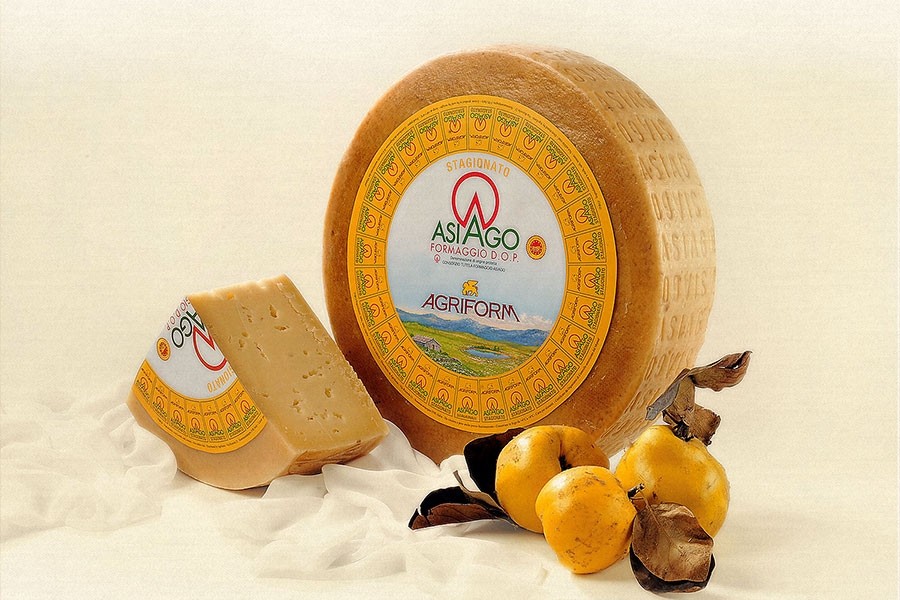Asiago Cheese P.D.O.
Product description
Asiago PDO is a semi-cooked cheese made with cow’s milk, produced in two typologies:
Pressato (pressed), with whole milk, and d’Allevo (nurtured) with skimmed milk, that has a more decisive flavour.
Production method
A starter culture, cow’s rennet and a small quantity of salt are added to the milk.
After curdling and breaking of the curd, the product is semi-cooked and pressed for around 12 hours;
the cheese forms are conserved for 48 hours in an environment with a temperature between 10-15°C. The forms are then dry salted or salted in brine.
The minimum period of ripening is 20 days for Asiago PDO Pressato and 60 days per Asiago PDO d’Allevo,
and the process must take place within the production area, in storerooms with a temperature of 10-15°C.
Asiago PDO accompanied by Prodotto della Montagna (Mountain Product, of an altitude higher than 600 m.a.s.l.),
must be obtained from the milk of mountain breeds that have been milked two or four times; in this case,
the ripening process lasts a minimum of 30 and 90 days respectively for Asiago PDO Pressato and Asiago PDO d’Allevo.
The product must be processed and ripened on the premises of businesses located in the mountains.
Apparence and flavour
Asiago PDO Pressato has a thin and elastic rind, with a white or slightly straw-colored interior that has irregular and defined eyes.
It has a soft, sweet and delicate flavour. Asiago PDO d’Allevo has a smooth and even rind, with a compact and grainy interior ranging
from straw yellow to amber in colour; there is a scattering of small-to-medium sized eyes.
It has a decisive and savoury flavour and a characteristic aroma.
Gastronomy
Asiago PDO Pressato has a shorter shelf life than the D’Allevo. In fact, Asiago PDO D’Allevo can be conserved for up to a month,
provided it is kept in a suitable environment. Asiago PDO should be wrapped in cling film and conserved at a temperature of 8-9°C.
Asiago PDO Pressato can be eaten alone or diced in salads, sliced over fried eggs, in baked pasta and as a pizza topping. Its delicacy requires white,
fruity and fresh wines or smooth rosés, such as Valpolicella PDO, Vernaccia di San Gimignano PDO and Biferno PDO Rosé.
Asiago PDO d’Allevo is best served with fresh fruit at the end of a meal. The Stravecchio typology (heavily aged) can be grated.
Marketing
The product is sold in the following typologies: Asiago PDO Pressato (incl. Fresh); Asiago PDO d’Allevo (incl. Matured);
on the label of the latter, the words Mezzano (medium aged), Vecchio (aged) or Stravecchio (heavily aged) may also be written.
Both typologies may indicate “Prodotto della Montagna” if produced in the mountain area. It is sold whole, in large slices or as pre-packed pieces.
Distinctive features
The freshly produced forms of Asiago PDO Pressato are pressed with the use of manual or hydraulic presses, hence the name.
Only at the termination of the pressing process, which lasts several hours, are the forms inserted into the molds.
History
In around 1,000 A.D, a delicious sheep’s milk cheese was produced on the plateau that gives Asiago PDO its name,
also known as the Altopiano dei Sette Comuni (The Plateau of the Seven Municipalities). In around the XVI century,
sheep were replaced by bovine, whose milk gave birth to the dairy technique that is still used in the Malghe region today.
D’Allevo is the oldest type of Asiago cheese, whereas production of the Pressato typology began during the 1920s.
Production area
The production area of Asiago PDO is within the territory of the Province of Vicenza,
as well as in two bordering areas in the provinces of Padua and Treviso, in the Veneto region;
within the Province of Trento, in the Trentino-Alto Adige region.
Opreators: 1.492
Production(KG): 21.828.200
Turnover(MLN€): 108,92

 IT
IT 